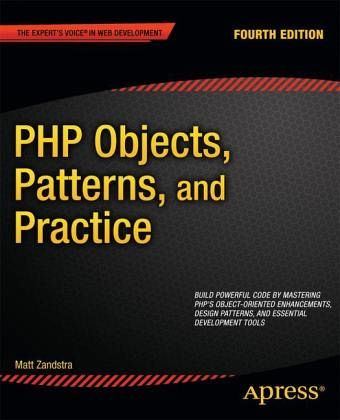Nicht lieferbar

PHP Objects, Patterns, and Practice
Versandkostenfrei!
Nicht lieferbar
PHP Objects Patterns and Practice, Fourth Edition is revised and updated throughout.The book begins by covering PHP's object-oriented features. It introduces key topics including class declaration, inheritance, reflection and much more. These provide the fundamentals of the PHP's support for objects. It also introduces some principles of design.This edition introduces new object relevant features such as traits, reflection extension additions, callable type hinting, improvements to exception handling, and many smaller language enhancements.The next section is devoted to design patterns. These ...
PHP Objects Patterns and Practice, Fourth Edition is revised and updated throughout.
The book begins by covering PHP's object-oriented features. It introduces key topics including class declaration, inheritance, reflection and much more. These provide the fundamentals of the PHP's support for objects. It also introduces some principles of design.
This edition introduces new object relevant features such as traits, reflection extension additions, callable type hinting, improvements to exception handling, and many smaller language enhancements.
The next section is devoted to design patterns. These describe common problems and their solutions. The section describes the design principles that make patterns powerful. It covers many of the classic design patterns and includes chapters on enterprise and database patterns.
The last segment of the book covers the tools and practices that can help turn great code into a successful project. The section shows how to manage multiple developers and releases with git, how to build and install using Phing and PEAR. It also explores strategies for automated testing and build.
In addition to discussing the latest developments in build, test, and continuous integration, this section keeps pace with best practice in version control by focusing on Git, increasingly the developer's system of choice.
Taken together these three elements: object fundamentals, design principles, and best practice will help the reader develop elegant and rock solid systems.
PHP Objects and Patterns:
Describes and demonstrates PHP's built-in object-oriented features
Breaks down the principles of object-oriented design, explaining key design patterns using practical examples.
Discusses the tools and practices necessary for developing, testing and deploying exemplary applications.
The book begins by covering PHP's object-oriented features. It introduces key topics including class declaration, inheritance, reflection and much more. These provide the fundamentals of the PHP's support for objects. It also introduces some principles of design.
This edition introduces new object relevant features such as traits, reflection extension additions, callable type hinting, improvements to exception handling, and many smaller language enhancements.
The next section is devoted to design patterns. These describe common problems and their solutions. The section describes the design principles that make patterns powerful. It covers many of the classic design patterns and includes chapters on enterprise and database patterns.
The last segment of the book covers the tools and practices that can help turn great code into a successful project. The section shows how to manage multiple developers and releases with git, how to build and install using Phing and PEAR. It also explores strategies for automated testing and build.
In addition to discussing the latest developments in build, test, and continuous integration, this section keeps pace with best practice in version control by focusing on Git, increasingly the developer's system of choice.
Taken together these three elements: object fundamentals, design principles, and best practice will help the reader develop elegant and rock solid systems.
PHP Objects and Patterns:
Describes and demonstrates PHP's built-in object-oriented features
Breaks down the principles of object-oriented design, explaining key design patterns using practical examples.
Discusses the tools and practices necessary for developing, testing and deploying exemplary applications.




